| Listing 1 - 10 of 48 | << page >> |
Sort by
|

ISBN: 1280956364 9786610956364 0387682651 0387343490 Year: 2007 Publisher: New York : Springer,
Abstract | Keywords | Export | Availability | Bookmark
 Loading...
Loading...Choose an application
- Reference Manager
- EndNote
- RefWorks (Direct export to RefWorks)
A diagnosis of cancer provokes myriad responses in patients, chief among them the question: "how long do I have to live?" Increasingly, the answer to that question is not one of months or years, but decades. While there are now nearly 10 million people in the United States who have recovered or are currently recovering from cancer (increased from three million in 1971), the unique challenges encountered by survivors are often met with uncertainty by even the most seasoned physicians, nurses, and clinical social workers because of a lack of formal guidelines for post-treatment care and follow-up. Cancer Survivorship: Today and Tomorrow provides much-needed information on how to best serve this community of patients. Written by experts in the field, many of the them cancer survivors themselves, each chapter leads the reader through the unique medical and psychosocial aspects of recovery and survivorship in many primary sites including Childhood Cancers, Hodgkin’s Disease, Testicular, Gynecological, Breast, Prostate, Lung, Colorectal, and Transplant (AML,ALL, Lymphoma). Additional chapters cover surveillance, second malignancies, psychosocial rehabilitation, employment and job discrimination, sexual and reproductive dysfunction, and advocacy. Cancer Survivorship is designed to be a complete resource for all members of the patient care team, providing a strong basis for the ongoing treatment of cancer survivors. From the foreword… "Dr. Ganz and many of the contributors to this comprehensive text pioneered cancer survivorship, and they must justifiably be proud that their advocacy and commitment to survivor care and research have resulted in in-depth reports by the President’s Cancer Panel, several Institute of Medicine studies, and this timely text. Cancer Survivorship: Today and Tomorrow is a natural evolution of these efforts, inclusive of the major areas of survivor care: surveillance for recurrence and second cancers, management of late effects, coordination of ongoing health maintenance and prevention, and the important psychosocial elements integral to the healing process after cancer treatment. Care of an entire generation of cancer survivors is needed and will be facilitated by the organization of this volume according to specific diseases, patient groups and cross-cutting topics." .
Cancer --- Patients --- Rehabilitation. --- Treatment. --- Psychological aspects. --- Cancer therapy --- Cancer treatment --- Therapy --- Oncology . --- Oncology. --- Hematology. --- Cancer Research. --- Haematology --- Internal medicine --- Blood --- Tumors --- Diseases --- Cancer research. --- Cancer research
Book
ISBN: 1281954012 9786611954017 0387746722 0387746706 144192566X Year: 2007 Publisher: New York : Austin, Tex. : Springer Science+Business Media ; Landes Bioscience,
Abstract | Keywords | Export | Availability | Bookmark
 Loading...
Loading...Choose an application
- Reference Manager
- EndNote
- RefWorks (Direct export to RefWorks)
Relaxin and Related Peptides discusses the established paradigms, the contradictions, and the most recent findings and future directions in the field of relaxin research. The array of diverse topics are highlighted, ranging from evolution of relaxin family peptides and receptors to their cell signaling, from the role of relaxin in reproduction to the newly discovered functions in cancer progression and in the nervous system. The four major ongoing areas of research described in this book will likely attract investigators for years to come, since many basic scientific questions remain unanswered at this time. The availability of structural databases, new experimental techniques, and high quality hormone preparations, antibodies and other reagents enable rigorous investigation. Relaxin and Related Peptides offers a fresh perspective along with different points of view, opinions and disagreements.
Relaxin. --- Peptide hormones. --- Hormonal peptides --- Polypeptide hormones --- Hormones --- Peptides --- Corpus luteum --- Hormones, Sex --- Peptide hormones --- Endocrinology. --- Cytology. --- Oncology. --- Cell Biology. --- Cancer Research. --- Tumors --- Cell biology --- Cellular biology --- Biology --- Cells --- Cytologists --- Internal medicine --- Endocrinology . --- Cell biology. --- Cancer research. --- Cancer research
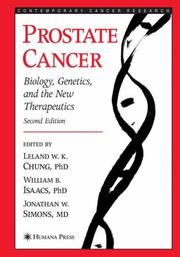
ISBN: 1280972068 9786610972067 1597452246 1588296962 Year: 2007 Publisher: Totowa, NJ : Humana Press,
Abstract | Keywords | Export | Availability | Bookmark
 Loading...
Loading...Choose an application
- Reference Manager
- EndNote
- RefWorks (Direct export to RefWorks)
Prostate Cancer: Biology, Genetics, and the New Therapeutics, Second Edition, reviews new, valuable approaches to the treatment of prostate cancer in men. The latest edition contains new material on molecular imaging, new treatments for prostate cancer, molecular targets, cell signaling pathways, bioinformatics, and pathogenomics. The book details the latest innovations and advances in prostate cancer and may be used as a rapid reference text for readers. The volume profiles the latest advances in cancer research and treatment and includes profound studies in prostate stem cells, cancer-host interactions, hedgehog signaling in development and cancer, cholesterol and cell signaling, gene therapy for advanced prostate cancer, and noninvasive strategies such as molecular imaging to visualize gene expression. This new edition also investigates expression profiling and somatic alterations in prostate cancer progression and linkage studies of prostate cancer families to identify susceptibility genes. The issues of racial differences in prostate cancer mortality, radiotherapy for the treatment of locally advanced prostate cancer, recombinant antibody candidates for treatment, taxane-based chemotherapy, lethal phenotypes, and novel and efficient translation clinical trials are also presented in great depth. Prostate Cancer: Biology, Genetics, and the New Therapeutics, Second Edition, provides readers with a general reference for prostate cancer from prevention to therapy and will be of value to clinicians, scientists, and administrators who strive to solve the cancer problem.
Prostate --- Cancer. --- Cancer --- Genetic aspects. --- Treatment. --- Urology. --- Oncology. --- Oncology . --- Radiotherapy. --- Cancer Research. --- Radiation therapy --- Electrotherapeutics --- Hospitals --- Medical electronics --- Medical radiology --- Therapeutics, Physiological --- Phototherapy --- Tumors --- Medicine --- Genitourinary organs --- Radiological services --- Diseases --- Cancer research. --- Cancer research
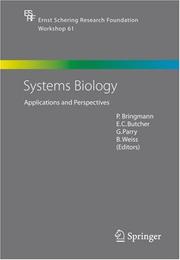
ISSN: 09476075 ISBN: 1280902639 9786610902637 3540313397 3540313389 364242158X Year: 2007 Volume: 61 Publisher: Berlin : Springer,
Abstract | Keywords | Export | Availability | Bookmark
 Loading...
Loading...Choose an application
- Reference Manager
- EndNote
- RefWorks (Direct export to RefWorks)
Systems biology has emerged as a highly interdisciplinary ?eld that has created broad enthusiasm in the scienti?c community. Systems biology is in vogue because of its potential to revolutionize not only biology but also medicine. Developments are anticipated that will change how we think about disease and how we approach therapeutic intervention. Perhaps the boldest vision of this future is presented by Dr. Leroy Hood, President of the Institute for Systems Biology in Seattle. He has been a protagonist and the main driving force of the underlying concept. - cording to Dr. Hood, systems biology will make possible a new era of medical care comprising predictive, preventive, personalized and part- ipatory (P4) medicine. While this vision appears futuristic, it has enticed both academic scienti?c communities and pharmaceutical industry R&D organizations. Systems biology ultimately attempts to understand biological s- tems at the molecular level. Examples of such systems are subcellular regulatory circuits with all their components, cells, organs, as well as - tire organisms. Over the past decade, technologies have been developed that enable systems-level interrogations, e.g., gene expression pro?ling, proteomics, and metabonomics, to name a few. Scientists have used such platforms to accumulate a tremendous amount of data. Although we have learned a great deal by collecting such detailed information, it seems our understanding has not similarly increased.
Biological systems --- Molecular biology --- Oncology. --- Cytology. --- Endocrinology. --- Cancer Research. --- Cell Biology. --- Internal medicine --- Hormones --- Cell biology --- Cellular biology --- Biology --- Cells --- Cytologists --- Tumors --- Cancer research. --- Cell biology. --- Endocrinology . --- Cancer research --- Biological control systems --- Pharmaceutical preparations
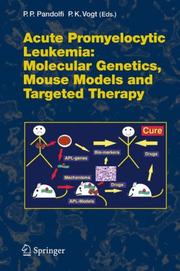
ISBN: 1280803789 9786610803781 3540345949 3540345922 Year: 2007 Publisher: Berlin : Springer,
Abstract | Keywords | Export | Availability | Bookmark
 Loading...
Loading...Choose an application
- Reference Manager
- EndNote
- RefWorks (Direct export to RefWorks)
Over the past 10 years, work on acute promyelocytic leukemia (APL) has become the paradigm of translational research that began with the discovery of a recurrent chromosomal translocation, followed by the identification of the genes and proteins involved, finding their molecular functions in transcriptional control, establishing mouse models and culminating in the development of targeted therapy.
Acute myeloid leukemia --- Pathogenesis. --- Treatment. --- Acute myelogenous leukemia --- Acute myeloid granulocytic leukemia --- Acute myelocytic leukemia --- AML (Disease) --- Acute leukemia --- Myeloid leukemia --- Oncology. --- Cancer Research. --- Tumors --- Cancer research. --- Cancer research
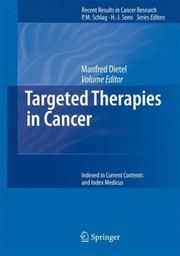
ISBN: 1280937327 9786610937325 3540460918 354046090X 3642432433 Year: 2007 Publisher: Berlin ; [London] : Springer,
Abstract | Keywords | Export | Availability | Bookmark
 Loading...
Loading...Choose an application
- Reference Manager
- EndNote
- RefWorks (Direct export to RefWorks)
From its introduction, oncological chemotherapy has been encumbered by its poor selectivity because most antiproliferative drugs are toxic not only to tumor cells but also to important populations of the body’s non-neoplastic cells. The resultant problems with unwanted side effects are compounded by difficulties in predicting the desired effectivity of chemotherapy in individual patients. This unsatisfactory situation has driven intensive research and development towards more specific and less toxic anticancer drugs over the last few decades. Several results of these efforts have reached the clinic and an even greater number are now in preclinical testing. Common to all these targeted therapies is their interaction with defined molecules present on cancer cells, which adds various degrees of increased selectivity to their toxic effects. As a consequence, detecting the target molecule on tumors before therapy holds great diagnostic potential for predicting the efficacy of the drug and personalizing therapy. This book aims to present translational scientists and clinicians with an integrated critical view on the theories, mechanisms, problems and pitfalls of the targeted therapy approach.
Cancer --- Drug targeting. --- Chemotherapy. --- Drugs --- Site-specific drug delivery --- Targeting of drugs --- Target organs (Anatomy) --- Antineoplastic agents --- Targeting --- Dosage forms --- Treatment --- Oncology . --- Oncology. --- Cancer Research. --- Tumors --- Cancer research. --- Cancer research
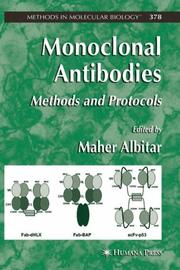
ISBN: 1280972017 9786610972012 1597453234 1588295672 Year: 2007 Publisher: Totowa, NJ : Humana Press : Imprint: Humana,
Abstract | Keywords | Export | Availability | Bookmark
 Loading...
Loading...Choose an application
- Reference Manager
- EndNote
- RefWorks (Direct export to RefWorks)
Monoclonal Antibodies: Methods and Protocols examines a collection of state-of-the-art methods that employ monoclonal antibodies in a clinical setting with opening chapters focusing on the gold standard method for generating mouse monoclonal antibodies through hybridoma technology, future methods for engineering recombinant and humanized antibodies, methods for engineering soluble Fc fusion protein, and the use of antibodies and flow cytometry in the quantification of cell signaling proteins. Specific chapters describe how antibodies are used for the diagnosis and classification of hematologic diseases. Subsequent chapters examine the advantages and most recent advances of using bead-based immunoassays, including the ability of bead-based technology to multiplex and analyze several analytes simultaneously, and the use of beads in detecting fusion proteins resulting from chromosomal translocations. Concluding chapters provide additional examples of methodologies that employ monoclonal antibodies. Monoclonal Antibodies: Methods and Protocols provides descriptions of methods that cover a wide spectrum of applications in the field of monoclonal antibodies. This field will continue to expand and provide new and innovative techniques, not only in the laboratory, but also as a basis that complements targeted therapy.
Immunology. --- Oncology. --- Medicine. --- Cancer Research. --- Molecular Medicine. --- Health Workforce --- Tumors --- Immunobiology --- Life sciences --- Serology
Periodical
Year: 2007 Publisher: Bethesda, MD : National Cancer Institute, Center for Cancer Research
Abstract | Keywords | Export | Availability | Bookmark
 Loading...
Loading...Choose an application
- Reference Manager
- EndNote
- RefWorks (Direct export to RefWorks)
Cancer --- AIDS (Disease) --- Research --- Center for Cancer Research (National Cancer Institute (U.S.)) --- United States. --- United States
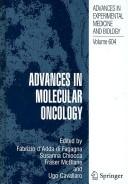
ISBN: 1280956836 9786610956838 0387691162 0387691146 1441943382 Year: 2007 Publisher: New York, N.Y. : Springer,
Abstract | Keywords | Export | Availability | Bookmark
 Loading...
Loading...Choose an application
- Reference Manager
- EndNote
- RefWorks (Direct export to RefWorks)
Proceedings of the 2nd Annual IFOM-IEO Meeting on Cancer. This is a new meeting, it has about 200 attendees from Australia, Austria, Belgium, Brazil, Canada, England, France, Germany, Greece, Ireland, Italy, Japan, Netherlands, Spain, Sweden, Switzerland, and the USA. The 2nd IFOM-IEO international meeting on cancer will provide a forum in which the world’s leading cancer researchers and young scientists will discuss the latest advances in molecular oncology. The impact of recent breakthroughs in basic research and of emerging technologies on molecular medicine in cancer will be highlighted.
Cancer --- Molecular aspects --- Oncology. --- Cytology. --- Chemistry, Physical organic. --- Cancer Research. --- Cell Biology. --- Physical Chemistry. --- Chemistry, Physical organic --- Chemistry, Organic --- Chemistry, Physical and theoretical --- Cell biology --- Cellular biology --- Biology --- Cells --- Cytologists --- Tumors --- Cancer research. --- Cell biology. --- Physical chemistry. --- Chemistry, Theoretical --- Physical chemistry --- Theoretical chemistry --- Chemistry --- Cancer research
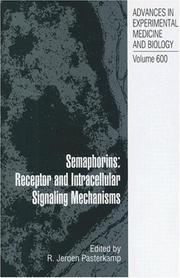
ISBN: 128113953X 9786611139537 0387709568 038770955X 1441924272 Year: 2007 Publisher: New York : Austin, Tex. : Springer Science+Business Media ; Landes Bioscience,
Abstract | Keywords | Export | Availability | Bookmark
 Loading...
Loading...Choose an application
- Reference Manager
- EndNote
- RefWorks (Direct export to RefWorks)
The book summarizes our progress in understanding the receptor and intracellular signaling mechanisms utilized by a family of proteins called the semaphorins. Originally these protein were identified as ""axon guidance cues"" important for the formation of nerve tracts but now it is realized that semaphorins subserve several distinct functions in a multitude of organ systems. The purpose of this book is to summarize our knowledge and make it available as a useful and comprehensive tool for the scientific community. This book will both be interesting for people working in the field as well as c
Semaphorins. --- Cell receptors. --- Cellular signal transduction. --- Cellular information transduction --- Information transduction, Cellular --- Signal transduction, Cellular --- Bioenergetics --- Cellular control mechanisms --- Information theory in biology --- Cell membrane receptors --- Cell surface receptors --- Receptors, Cell --- Binding sites (Biochemistry) --- Cell membranes --- Proteins --- Semaphorin --- Carrier proteins --- Neurosciences. --- Oncology. --- Immunology. --- Cancer Research. --- Immunobiology --- Life sciences --- Serology --- Neural sciences --- Neurological sciences --- Neuroscience --- Medical sciences --- Nervous system --- Tumors --- Cancer research. --- Cancer research
| Listing 1 - 10 of 48 | << page >> |
Sort by
|

 Search
Search Feedback
Feedback About UniCat
About UniCat  Help
Help News
News